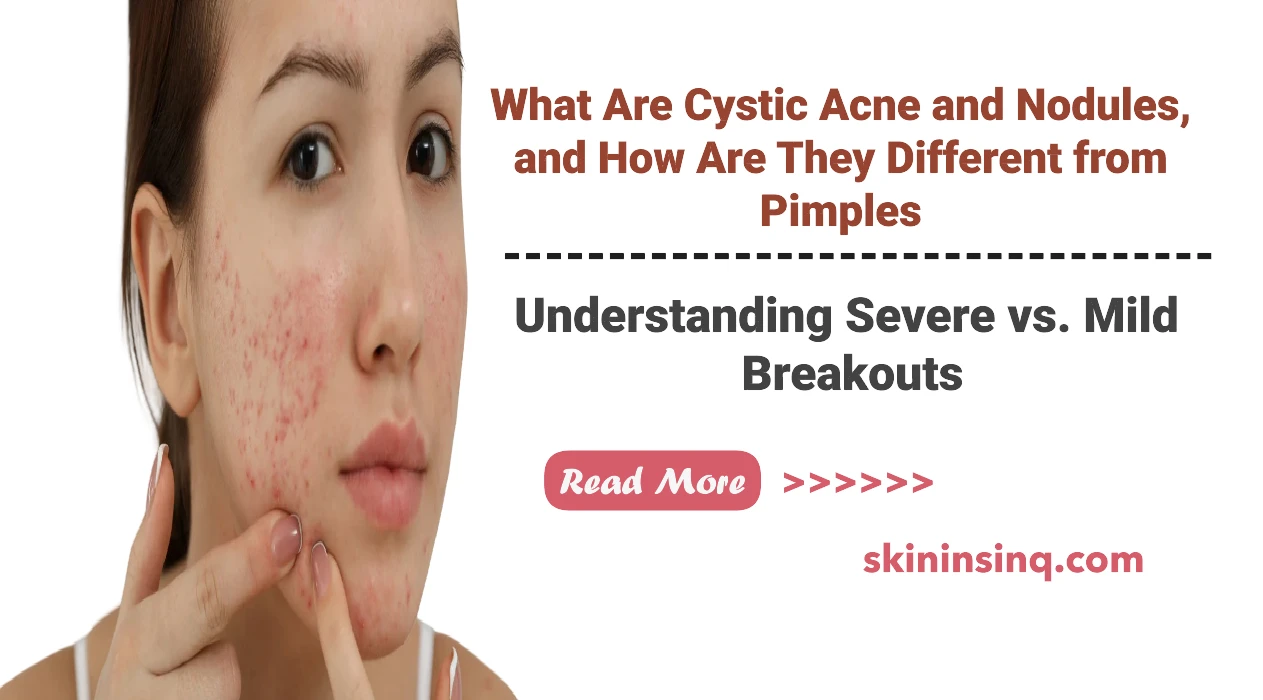What Are Cystic Acne and Nodules, and How Are They Different from Pimples? Understanding Severe vs. Mild Breakouts
What Are Cystic Acne and Nodules, and How Are They Different from Pimples? Understanding Severe vs. Mild Breakouts
Acne is a common skin condition that affects millions of people worldwide, but not all acne is the same. While mild breakouts like pimples are common and manageable, more severe types—such as cystic acne and nodules—require deeper understanding and often medical treatment. Knowing the difference between these forms of acne can help you make better choices in skincare and treatment.
What Are Pimples?
Pimples, the most recognizable and mild form of acne, are small, red, inflamed bumps that often appear on the face, back, or chest. They form when hair follicles become clogged with excess oil (sebum), dead skin cells, and bacteria. There are several types of pimples, including:
-
Whiteheads: Closed clogged pores.
-
Blackheads: Open clogged pores.
-
Papules: Small red bumps.
-
Pustules: Pimples with pus at the tip.
Pimples are usually surface-level and respond well to over-the-counter treatments containing ingredients like benzoyl peroxide or salicylic acid. They may cause minor discomfort but typically heal within a few days to a week.
What Is Cystic Acne?
Cystic acne is the most severe form of acne. It develops when bacteria, oil, and dead skin become trapped deep within hair follicles, leading to large, swollen, painful lumps beneath the skin. These cysts are filled with pus and may feel soft or fluid-filled.
-
Characteristics:
-
Deep under the skin
-
Painful to touch
-
Often leaves scars
-
May last for weeks or even months
-
-
Common Causes:
-
Hormonal changes (especially during puberty or menstruation)
-
Genetics
-
High-stress levels
-
Cystic acne is not easily treated with topical products. It usually requires prescription treatments such as oral antibiotics, hormonal therapy, or isotretinoin (Accutane).
What Are Nodules?
Nodular acne is similar to cystic acne but differs in texture and composition. Nodules are large, hard bumps that form deep under the skin, but unlike cysts, they do not contain pus. They are firm to the touch and often more painful than pimples.
-
Characteristics:
-
Deep, solid, and inflamed
-
Painful and slow to heal
-
More likely to scar
-
-
Treatment:
-
Requires dermatologist care
-
Prescription treatments often necessary
-
Key Differences Between Pimples, Nodules, and Cystic Acne
| Feature | Pimples | Nodules | Cystic Acne |
|---|---|---|---|
| Depth | Surface-level | Deep within the skin | Deeper than nodules |
| Pain Level | Mild | Moderate to severe | Severe |
| Pus Presence | Often present | Absent | Present |
| Texture | Soft or firm | Hard and solid | Soft, fluid-filled |
| Healing Time | Days to a week | Weeks | Weeks to months |
| Scarring Risk | Low | High | Very high |
Conclusion
While pimples are a common and manageable part of acne, cystic acne and nodules represent more severe, painful, and long-lasting forms of the condition. These deeper types often require medical treatment to avoid permanent scarring and prolonged skin damage. If you suspect you’re dealing with nodules or cystic acne, it’s best to seek advice from a dermatologist for proper diagnosis and treatment.

Related Blog
Can People with Dry Skin Also Have Acne? Understanding Breakouts Beyond Oily Skin Types
Aug 2, 2025 by Admin
General Acne
What Causes Oily Skin and Can It Be Managed Naturally? Exploring Root Causes and Gentle Solutions
Aug 2, 2025 by Admin
General
Does Popping Pimples Always Make Acne Worse? The Risks and Realities of Squeezing Breakouts
Aug 2, 2025 by Admin
General Acne
Do Oily Foods Make Pimples Worse? Uncovering the Truth Behind Diet and Breakouts
Aug 2, 2025 by Admin
General Acne